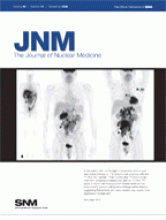Article Figures & Data
Tables
Parameter evaluated for damage Exclusion criterion No. of patients excluded Salivary glands History of salivary gland disorders 0 Use of anticholinergic drugs 1 Report of recurrent or persistent pain or enlargement of salivary glands 1 Hyperamylasemia before 131I administration 3 Ovaries History of oophorectomy, chemotherapy, or pelvic radiotherapy 0 Increased FSH before 131I 20 Testes History of chemotherapy, orchiepididymitis, cryptorchidism 1 Varicocele or infertility 1 Increased FSH before 131I 1 Hematologic Known hematologic disease 0 Neutrophils < 1,800/mm3 2 Platelets < 150,000/mm3 1 Hemoglobin < 12 g/dL 1 Oxidative Diabetes 0 Smoker 7 Parameter evaluated for damage Test Time of evaluation Salivary glands Serum amylase Immediately before and 48 h after 131I* Enlargement or pain in salivary glands 2 and 7 d after 131I Ovaries Serum FSH Immediately before and 6 mo after 131I* Testes Serum FSH Immediately before and 6 mo after 131I* Hematologic Blood count Immediately before and 30, 45, and 60 d after 131I Oxidative Plasma 8-epi-PGF2α Immediately before and 4 d after 131I* ↵* Significant increases in levels of amylase (4,5), FSH (6–9), and 8-epi-PGF2α (10) after 131I were seen at these times.
Characteristic Group A (rhTSH; n = 30) Group B (hypothyroidism; n = 64) Age (y) 45 ± 9.5 44 ± 11 Sex Female: 20; male: 10 Female: 44; male: 20 Histologic type Papillary: 27; follicular: 3 Papillary: 58; follicular: 6 Tumor size (cm) 2.7 ± 0.7 2.5 ± 0.6 Minimal extrathyroidal invasion 6 (20%) 14 (22%) Tumor size ≤ 2 cm 10 (33.3%) 23 (36%) Tumor size > 2 and ≤ 4 cm 11 (36.6%) 21 (33%) Tumor size > 4 cm or extrathyroid invasion 9 (30%) 20 (31.2%) Interval between thyroidectomy and ablation (d) 102 ± 21 106 ± 18 TSH immediately before 131I administration (mIU/L)* 118 ± 28.5 85 ± 23 ↵* P < 0.05.
Outcome Group A (rhTSH) Group B (hypothyroidism) P Elevated FSH 6 mo after 131I Men 4/9 (44.4%) 16/18 (89%) 0.03 Women 1/13 (7.7%) 6/30 (20%) 0.4 Mean increase of FSH Men 105% 236% <0.001 Women 65% 125% <0.001 Hyperamylasemia 48 h after 131I* 11/30 (36.6%) 48/60 (80%) <0.001 Symptoms of acute sialoadenitis up to 7 d after 131I* 9/30 (30%) 35/60 (58.3%) 0.01 Thrombocytopenia (<100,000/mm3) or neutropenia (<1,500/mm3) (lowest count) up to 60 d after 131I† 2/28 (7%) 12/56 (21.4%) 0.1 Mean decrease of neutrophils (considering lowest count)‡ 20% 45% <0.01 Mean decrease of platelets (considering lowest count)‡ 25% 52% <0.01 Increased 8-epi-PGF2α 96 h after 131I 14/25 (56%) 45/45 (100%) <0.001 Mean increase of 8-epi-PGF2α 60% 125% <0.001 ↵* All symptomatic patients presented with concomitant hyperamylasemia. No cause other than salivary gland damage was suspected for increase in serum amylase in any patient.
↵† One patient showed platelet count of less than 75,000/mm3 and other-neutrophil count of less than 1,000/mm3. Thrombocytopenia or neutropenia was observed 30, 45, and 60 d after 131I administration in 4, 8, and 2 patients, respectively.
↵‡ Lowest platelet count was observed 30, 45, and 60 d after ablation in 20, 44, and 20 patients, respectively. Lowest neutrophil count was observed 30, 45, and 60 d after ablation in 16, 40, and 28 patients, respectively.







